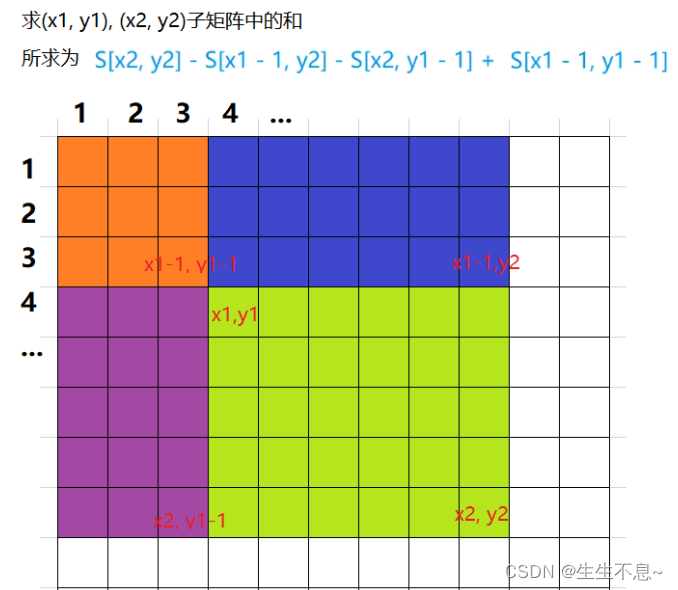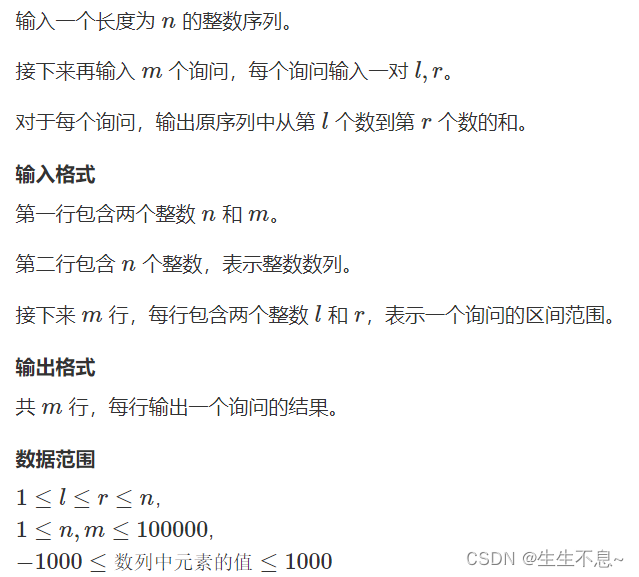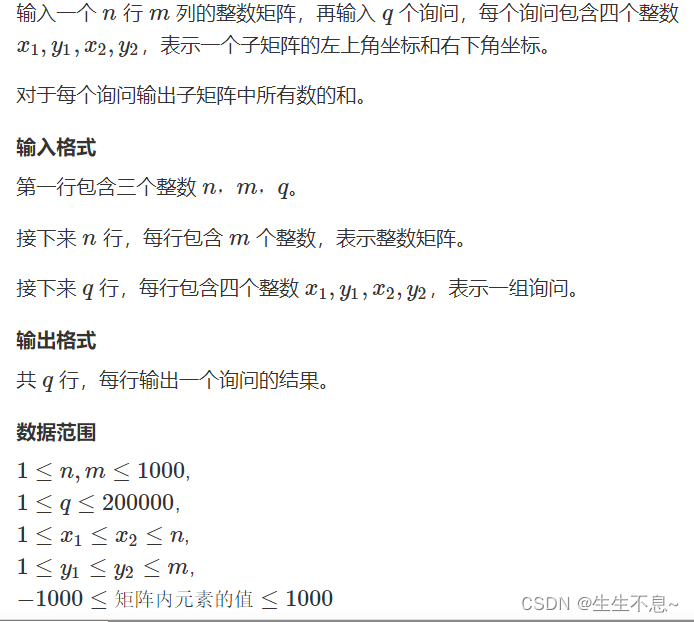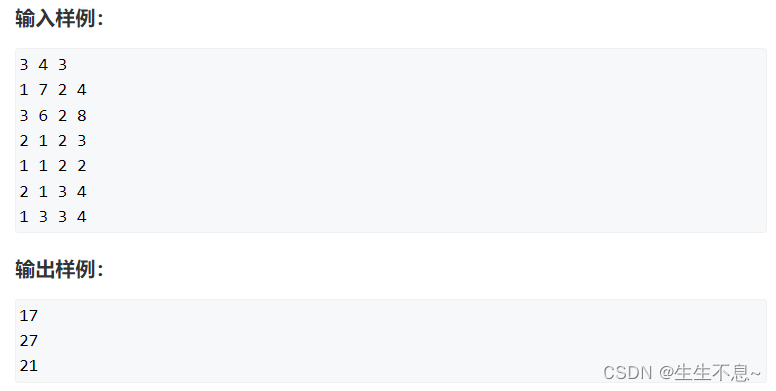【基础算法】前缀和
发布时间:2023年12月17日
算法介绍
什么是前缀和??
数组: a[1], a[2], a[3], a[4], a[5], …, a[n]
前缀和 Si为数组的前 i项和
前缀和: S[i] = a[1] + a[2] + a[3] + … + a[i]
注意: 前缀和的下标建议要从 1开始, 避免进行下标的转换
s[0] = 0
s[1] = a[1]
s[2] = a[1] + a[2]
前缀和的作用
快速求出元素组中某段区间的和
一维数组求解前缀和(Si)
for循环求出 每个S[i] (将 S[0] 定义为 0, 避免下标的转换)
求 [l, r]中的和, 即为 S[r] - S[l-1]
二维数组求解前缀项和
求解s[i][j],如图所示:

示例题目1:acwing795


import java.util.*;
public class Main {
private static int N = 100010; // 定义数组大小, 防止越界
public static void main(String[] args) {
// 初始化输入值
Scanner in = new Scanner(System.in);
int n = in.nextInt();
int m = in.nextInt();
int[] arr = new int[N];
// 注意这里是从 1开始的
for (int i = 1; i <= n; i++)
arr[i] = in.nextInt();
// s[i]代表 arr的前 i项和
int s[] = new int[N];
s[0] = 0;
// 计算出 s[i]
for (int i = 1; i <= n; i++)
s[i] = s[i - 1] + arr[i]; // 注意运算方式
// 循环输出
while (m-- > 0) {
int l = in.nextInt();
int r = in.nextInt();
System.out.println(s[r] - s[l - 1]); // 关键
}
}
}
示例题目2:acwing796


代码实现如下:
import java.util.*;
public class Main {
public static void main(String[] args) {
// 输入值进行初始化
Scanner in = new Scanner(System.in);
int n = in.nextInt();
int m = in.nextInt();
int q = in.nextInt();
// 初始化 arr
int[][] arr = new int[n + 1][m + 1];
for (int i = 1; i <= n; i++)
for (int j = 1; j <= m; j++)
arr[i][j] = in.nextInt();
// 输出查看 arr
// for (int i = 1; i <= n; i++) {
// for (int j = 1; j <= m; j++)
// System.out.print(arr[i][j] + " ");
// }
// 求解 s[i][j]
int[][] s = new int[n + 1][m + 1];
for (int i = 1; i <= n; i++)
for (int j = 1; j <= m; j++)
// 计算, 结合图来理解
s[i][j] = s[i - 1][j] + s[i][j - 1] - s[i - 1][j - 1] + arr[i][j];
// 循环输出
while (q-- > 0) {
// 定位获取区间大小
int x1 = in.nextInt();
int y1 = in.nextInt();
int x2 = in.nextInt();
int y2 = in.nextInt();
// 计算, 结合图来理解
int res = s[x2][y2] - s[x1 - 1][y2] - s[x2][y1 - 1] + s[x1 - 1][y1 - 1];
System.out.println(res);
}
}
}
总结收获
前缀和的解题思路其实都是先得到相应的和s,然后根据公式求得对应的前缀和,公式一定要理解,不能死记硬背!一/二维前缀和模板总结如下:
一维前缀和
S[i] = a[1] + a[2] + ... a[i]
a[l] + ... + a[r] = S[r] - S[l - 1]
二维前缀和
S[i, j] = 第i行j列格子左上部分所有元素的和
以(x1, y1)为左上角,(x2, y2)为右下角的子矩阵的和为:
S[x2, y2] - S[x1 - 1, y2] - S[x2, y1 - 1] + S[x1 - 1, y1 - 1]
文章来源:https://blog.csdn.net/qq_45858191/article/details/135051732
本文来自互联网用户投稿,该文观点仅代表作者本人,不代表本站立场。本站仅提供信息存储空间服务,不拥有所有权,不承担相关法律责任。 如若内容造成侵权/违法违规/事实不符,请联系我的编程经验分享网邮箱:chenni525@qq.com进行投诉反馈,一经查实,立即删除!
本文来自互联网用户投稿,该文观点仅代表作者本人,不代表本站立场。本站仅提供信息存储空间服务,不拥有所有权,不承担相关法律责任。 如若内容造成侵权/违法违规/事实不符,请联系我的编程经验分享网邮箱:chenni525@qq.com进行投诉反馈,一经查实,立即删除!
最新文章
- Python教程
- 深入理解 MySQL 中的 HAVING 关键字和聚合函数
- Qt之QChar编码(1)
- MyBatis入门基础篇
- 用Python脚本实现FFmpeg批量转换
- 103基于matlab的极限学习机(ELM)和改进的YELM和集成极限学习机(EELM)是现在流行的超强学习机
- redis内存淘汰机制
- 超声波传感器(附:c语言测距代码)
- 基于STM32的恒温控制箱系统设计
- uni-app上传音频,图片步骤
- openssl3.2 - 官方demo学习 - saccept.c
- 如何快速制作动态gif图?制作gif动图就这么简单
- Springboot + easyui + mybatis 高级搜索功能实现
- 【.NET Core】记录(Record)详解
- RT-Thread 之 PIN设备驱动调试